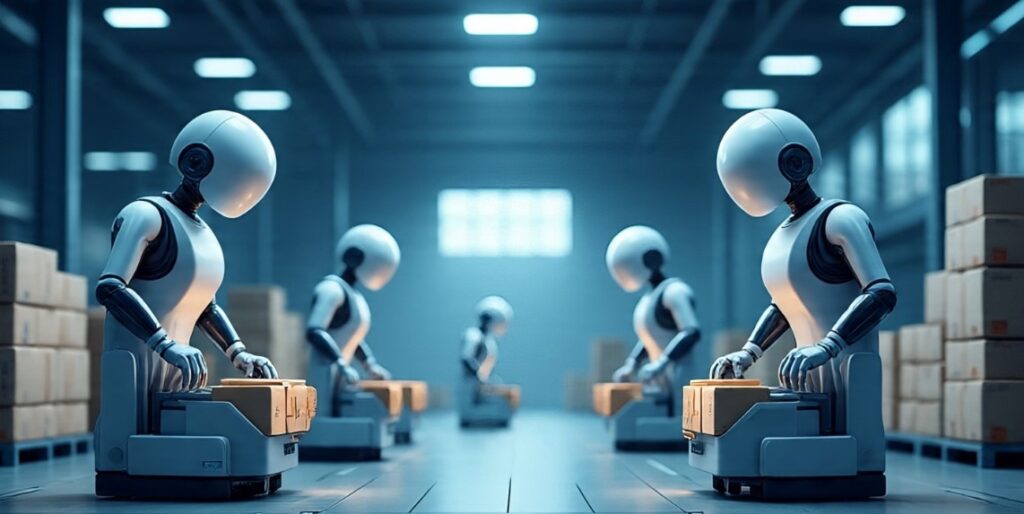AI Predictive Maintenance in Manufacturing: Revolutionizing Industrial Processes
The integration of artificial intelligence (AI) is rapidly transforming various sectors, and manufacturing is no exception. AI predictive maintenance in manufacturing is emerging as a game-changer, offering significant improvements in efficiency, cost savings, and overall productivity. By leveraging AI algorithms to analyze sensor data from industrial equipment, manufacturers can predict potential failures before they occur, minimizing costly downtime and optimizing maintenance schedules. This proactive approach not only reduces operational disruptions but also enhances the lifespan of machinery and improves safety standards.
How AI Predicts Equipment Failures
AI predictive maintenance relies on sophisticated algorithms that analyze vast quantities of data collected from various sensors embedded within industrial equipment. These sensors monitor parameters such as temperature, vibration, pressure, and current. Machine learning models, specifically deep learning techniques, are trained on historical data to identify patterns and anomalies that indicate potential equipment malfunctions. Once trained, the AI system can accurately predict the likelihood and timing of equipment failures, allowing for timely intervention.
For example, an AI system monitoring a production line’s conveyor belt might detect subtle changes in vibration patterns indicative of bearing wear. This early warning enables maintenance teams to replace the bearings before they fail, preventing production delays and costly repairs. Similarly, AI can predict the potential failure of critical components in manufacturing robots, ensuring timely maintenance and minimizing production disruptions.
Real-World Applications of AI Predictive Maintenance in Manufacturing
- Predictive maintenance for CNC machines: AI can monitor CNC machine performance, predicting tool wear and potential breakdowns, leading to optimized tool changes and reduced downtime.
- Predictive maintenance for robotic arms: Monitoring the performance of robotic arms, AI algorithms can predict potential failures in motors, sensors, or actuators, enabling proactive maintenance and enhanced production reliability.
- Predictive maintenance for industrial engines: Analysis of engine vibration, temperature, and pressure data allows AI to predict potential engine failures, thus avoiding significant production halts and potential safety risks.
The ROI of AI Predictive Maintenance in Manufacturing
Investing in AI predictive maintenance offers a substantial return on investment (ROI). By preventing unexpected downtime, manufacturers can avoid significant production losses and associated costs. A study by Gartner predicted that by 2025, over 80% of industrial organizations would utilize AI-powered maintenance strategies.Learn more about maximizing ROI. Furthermore, AI-driven maintenance reduces the need for reactive maintenance, resulting in lower labor costs and reduced consumption of spare parts. The improved equipment lifespan also contributes to long-term cost savings.
Beyond financial benefits, AI predictive maintenance leads to improved operational efficiency and enhanced safety. By identifying potential failures before they cause accidents or injuries, manufacturers can create safer working environments. It allows for more efficient resource allocation, leading to greater productivity and overall competitiveness in the market.
Implementing AI Predictive Maintenance: A Strategic Approach
Successfully implementing AI predictive maintenance requires a well-defined strategy. This involves several key steps, including:
- Data Acquisition and Integration: Gathering and integrating data from various equipment sensors is crucial. This requires robust data collection infrastructure and data integration capabilities.
- Algorithm Selection and Training: Choosing the right AI algorithms and training them effectively on relevant historical data is essential for accurate predictions.
- Integration with Existing Systems: Seamless integration of the AI system with existing manufacturing systems (e.g., CMMS) is necessary for efficient data flow and decision-making.
- Change Management: Successfully implementing AI predictive maintenance requires buy-in from all stakeholders, including management, maintenance personnel, and operators.
“The key to successful AI predictive maintenance is not just the technology itself, but also the people and processes that support it,” says Dr. Anya Petrova, a leading expert in industrial AI. Effective change management and employee training are vital for a smooth transition.
AI Predictive Maintenance in Manufacturing: The Future of Industrial Operations
AI predictive maintenance is revolutionizing industrial processes, offering manufacturers significant advantages in terms of efficiency, cost savings, and safety. As AI technologies continue to advance, we can expect even more sophisticated and effective solutions to emerge, further enhancing the capabilities and profitability of manufacturing operations. The proactive, data-driven approach of AI predictive maintenance paves the way for a more resilient, responsive, and sustainable manufacturing future. The adoption of AI predictive maintenance in manufacturing is not merely a trend; it is a necessity for remaining competitive in today’s rapidly evolving industrial landscape.
For more information on the impact of AI on manufacturing, refer to this insightful article from Wired and this report from McKinsey.
Frequently Asked Questions
What are the key benefits of AI predictive maintenance?
AI predictive maintenance offers significant benefits, including reduced downtime, lower maintenance costs, improved operational efficiency, enhanced safety, and increased equipment lifespan.
How does AI predict equipment failures?
AI algorithms analyze sensor data from equipment to identify patterns and anomalies that indicate potential failures. Machine learning models are trained on historical data to predict the likelihood and timing of these failures.
What is the return on investment (ROI) of AI predictive maintenance?
The ROI of AI predictive maintenance is substantial. It reduces downtime costs, labor costs, and spare parts consumption, leading to significant cost savings and improved productivity.
What are the steps involved in implementing AI predictive maintenance?
Implementation involves data acquisition and integration, algorithm selection and training, integration with existing systems, and effective change management to ensure stakeholder buy-in.



